 |
|
Lesson 1 Are you ready? Whether you are a complete beginner
or have played for years, plan to spend at least 5 minutes on each section
of this lesson. Some may only need to do it once and move on to lesson
2, while others may want to spend 10-15 minutes a day for a week before
continuing with lesson 2. |
|||||||||||||||||||||||
|
|
|||||||||||||||||||||||
|
Basic Theory I do not want to get to deep into music theory on
the first lesson as I know you would probably like to play something.
|
|||||||||||||||||||||||
 |
The piano is such a great visual instrument we will use it occasionally when talking about music theory. | ||||||||||||||||||||||
| The remaining 5 notes are
the black keys and can be called a sharp (#) or a flat (b). Ex. The black key in between C and D on the piano has 2 names. Sometimes we will call it C sharp (C#) and sometimes D flat (Db) depending on the context. |
|||||||||||||||||||||||
|
The sharp sign (#) |
A#=Bb
C#=Db D#=Eb F#=Gb G#=Ab |
The flat sign (b) |
|||||||||||||||||||||
|
|
|||||||||||||||||||||||
|
Let's apply this new knowledge to the guitar. Notice on the piano above, there is no black key between E and F or between B and C. To help us remember these half steps we can think of Bert and Ernie from Sesame Street. |
|||||||||||||||||||||||
|
|
Anytime you land on a B (Bert), the next fret higher is C |
Land on E (Ernie) and the very next fret higher is F | |||||||||||||||||||||
|
Any other alphabet letter you land on will have a whole step to the next alphabet letter. On the fretboard below, you can see this on both the E string and the D string. |
|||||||||||||||||||||||
 |
|||||||||||||||||||||||
|
The most important thing to remember for right now
is that we use 7 alphabet letters (A B C D E F G) and that there is
a half step between B to C and E to F. This means there is a whole
step between all other alphabet letters. |
|||||||||||||||||||||||
|
|
|||||||||||||||||||||||
|
Finger Gymnastics Ok enough theory! Hope that didn't make your head
spin. It will all make sense in due time. Right now let's get the fingers
on the fretboard. We are not worrying about note names just yet. |
|||||||||||||||||||||||
1st Position
|
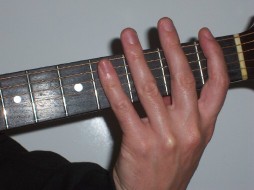 |
||||||||||||||||||||||
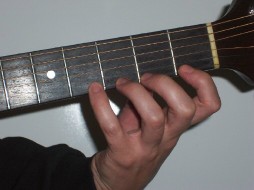 |
Place your 1st finger on the 1st fret and pluck the 1st string. Next, do not move your 1st finger and place your second finger on the second fret and pluck 1st string. Continue adding 3 and 4. When you get to the 4th finger on the 4th fret you should have all 4 fingers on the fretboard. | ||||||||||||||||||||||
| Proceed to work your way
back down by removing one finger at a time. As you remove each finger
concentrate to keep them hovering as close to the fingerboard as possible. Practice daily working to play steady and keeping your fingers as close as possible to the fretboard. This is an exercise you start today and play forever. The different finger combinations are almost endless. Create your own finger gymnastic exercises. |
|||||||||||||||||||||||
|
|
|||||||||||||||||||||||
|
Open Strings Next. Let's name our strings and play! |
|||||||||||||||||||||||
 |
|
 |
|||||||||||||||||||||
We have
two E strings.
|
|||||||||||||||||||||||
| We read music on a staff.
The staff consists of five lines and we can place notes on both the lines
and in the spaces between the lines. We will learn more in the reading
exercise ment to accompany this lesson. For now this is what our strings look like on the staff: |
|||||||||||||||||||||||
 |
|||||||||||||||||||||||
|
|
|||||||||||||||||||||||
| Up and down open strings
6 3 2 1 (You do not need your fret hand at all). Do not worry about the time signature or counting just yet. Use your ears. Metallica - Nothing Else Matters |
|||||||||||||||||||||||
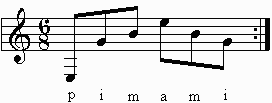 |
|||||||||||||||||||||||
|
p = thumb
i = index m = middle a = ring |
|||||||||||||||||||||||
| This is a great exercise to
practice with both a pick and your fingers. When using a pick the first
4 notes should be down picked and then up pick the last 2. Nothing Else Matters is on 1991 Self Titled Metallica (known as the Black album). |
|||||||||||||||||||||||
|
|
|||||||||||||||||||||||
|
Chords Let's have a little fun with some easy chords. We will learn more about chords in lesson 3 but for now we just need to know that a chord is 3 or more notes played at the same time. |
|||||||||||||||||||||||
|
With the E minor chord we can strum all 6 strings. Just like picking your open strings, you should try strumming up and down. You will see the E minor chords written as Em and sometimes E- and sometimes Emin. |
 |
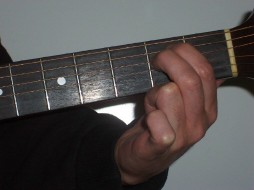 |
|||||||||||||||||||||
|
With the A major chord we want to avoid hitting the low E string. When you make the switch from Em to A just lift fingers 1 and 2 up and move them from strings 4 and 5 to 3 and 4 and drop your 3rd finger underneath 2 on string 2. |
 |
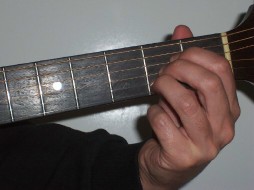 |
|||||||||||||||||||||
|
|
|||||||||||||||||||||||
|
Reading The first 15 lessons have reading exercises ment to accompany the lessons. In most cases you should do the reading exercise first as it usually has some things in it to help with the lesson. |
|||||||||||||||||||||||
|
|
|||||||||||||||||||||||
|
Practice Daily Practice Routine: open strings, alternate picking, finger gymnastics, changing chords from Em to A |
|||||||||||||||||||||||
|
Vancouver British Columbia Canada 604 357-3551 http://www.musiclearning.com |